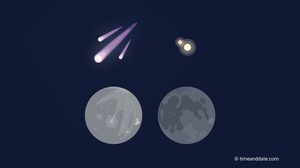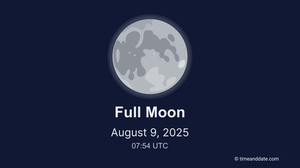| Current Time: | Aug 23, 2025 at 9:14:53 pm |
|---|---|
| Moon Direction: | 285.87° WNW↑ |
| Moon Altitude: | -13.82° |
| Moon Distance: | 242,428 mi |
| Next Full Moon: | Sep 7, 2025, 2:08 pm |
| Next New Moon: | Sep 21, 2025, 3:54 pm |
| Next Moonrise: | Tomorrow, 8:08 am |
Moonrise, Moonset, and Phase Calendar for Miami, January 2025
Scroll right to see more
| 2025 | Moonrise/Moonset | Meridian Passing | ||||||||
|---|---|---|---|---|---|---|---|---|---|---|
| Jan | Moonrise | Moonset | Moonrise | Time | Distance (mi) | Illumination | ||||
| 1 | 8:44 am | ↑ (117°) | 7:32 pm | ↑ (245°) | - | 2:06 pm | (40.4°) | 235,603 | 4.1% | |
| 2 | 9:28 am | ↑ (112°) | 8:36 pm | ↑ (251°) | - | 2:59 pm | (45.2°) | 233,833 | 9.8% | |
| 3 | 10:06 am | ↑ (106°) | 9:38 pm | ↑ (258°) | - | 3:49 pm | (51.1°) | 232,429 | 17.6% | |
| 4 | 10:41 am | ↑ (98°) | 10:40 pm | ↑ (265°) | - | 4:37 pm | (57.8°) | 231,368 | 27.2% | |
| 5 | 11:15 am | ↑ (91°) | 11:41 pm | ↑ (273°) | - | 5:24 pm | (64.7°) | 230,625 | 38.1% | |
| 11:48 am | ↑ (83°) | - | - | 6:12 pm | (71.7°) | 230,171 | 49.8% | |||
| 7 | - | 12:42 am | ↑ (281°) | 12:24 pm | ↑ (76°) | 7:01 pm | (78.3°) | 230,014 | 61.5% | |
| 8 | - | 1:46 am | ↑ (288°) | 1:02 pm | ↑ (69°) | 7:54 pm | (84.1°) | 230,188 | 72.5% | |
| 9 | - | 2:52 am | ↑ (294°) | 1:46 pm | ↑ (64°) | 8:50 pm | (88.7°) | 230,758 | 82.4% | |
| 10 | - | 3:59 am | ↑ (299°) | 2:36 pm | ↑ (60°) | 9:50 pm | (88.3°) | 231,784 | 90.3% | |
| 11 | - | 5:06 am | ↑ (301°) | 3:34 pm | ↑ (58°) | 10:51 pm | (87.3°) | 233,310 | 96.0% | |
| 12 | - | 6:09 am | ↑ (302°) | 4:36 pm | ↑ (59°) | 11:52 pm | (88.2°) | 235,325 | 99.2% | |
| - | 7:05 am | ↑ (300°) | 5:40 pm | ↑ (61°) | Moon does not pass the meridian on this day. | |||||
| 14 | - | 7:53 am | ↑ (297°) | 6:43 pm | ↑ (65°) | 12:49 am | (89.1°) | 237,758 | 99.7% | |
| 15 | - | 8:35 am | ↑ (292°) | 7:43 pm | ↑ (71°) | 1:42 am | (85.0°) | 240,457 | 97.9% | |
| 16 | - | 9:10 am | ↑ (286°) | 8:40 pm | ↑ (77°) | 2:30 am | (79.9°) | 243,243 | 93.8% | |
| 17 | - | 9:41 am | ↑ (280°) | 9:34 pm | ↑ (83°) | 3:14 am | (74.2°) | 245,892 | 88.0% | |
| 18 | - | 10:10 am | ↑ (273°) | 10:25 pm | ↑ (90°) | 3:55 am | (68.3°) | 248,192 | 80.8% | |
| 19 | - | 10:38 am | ↑ (267°) | 11:16 pm | ↑ (97°) | 4:35 am | (62.3°) | 249,938 | 72.5% | |
| 20 | - | 11:06 am | ↑ (260°) | - | 5:14 am | (56.4°) | 250,975 | 63.4% | ||
| 12:07 am | ↑ (103°) | 11:35 am | ↑ (254°) | - | 5:54 am | (50.9°) | 251,194 | 53.9% | ||
| 22 | 1:00 am | ↑ (109°) | 12:07 pm | ↑ (249°) | - | 6:36 am | (45.8°) | 250,549 | 44.2% | |
| 23 | 1:55 am | ↑ (114°) | 12:44 pm | ↑ (244°) | - | 7:21 am | (41.4°) | 249,070 | 34.6% | |
| 24 | 2:52 am | ↑ (118°) | 1:25 pm | ↑ (241°) | - | 8:10 am | (37.9°) | 246,846 | 25.5% | |
| 25 | 3:50 am | ↑ (121°) | 2:14 pm | ↑ (238°) | - | 9:03 am | (35.7°) | 244,051 | 17.1% | |
| 26 | 4:48 am | ↑ (122°) | 3:09 pm | ↑ (238°) | - | 9:59 am | (34.9°) | 240,903 | 9.9% | |
| 27 | 5:44 am | ↑ (121°) | 4:11 pm | ↑ (240°) | - | 10:57 am | (35.9°) | 237,680 | 4.4% | |
| 28 | 6:36 am | ↑ (119°) | 5:16 pm | ↑ (243°) | - | 11:54 am | (38.7°) | 234,644 | 1.0% | |
| 7:22 am | ↑ (114°) | 6:22 pm | ↑ (248°) | - | 12:49 pm | (43.1°) | 232,060 | 0.2% | ||
| 30 | 8:03 am | ↑ (108°) | 7:27 pm | ↑ (255°) | - | 1:42 pm | (48.8°) | 230,100 | 2.1% | |
| 31 | 8:40 am | ↑ (101°) | 8:30 pm | ↑ (263°) | - | 2:32 pm | (55.4°) | 228,863 | 6.8% | |
| * All times are local time for Miami. They take into account refraction. Dates are based on the Gregorian calendar. Illumination is calculated at lunar noon. | ||||||||||
Jan | Feb | Mar | Apr | May | Jun | Jul | Aug | Sep | Oct | Nov | Dec
Elsewhere on timeanddate.com

Sirius and the Dog Days of Summer
See Sirius return to the night sky around late summer and discover its ancient link to the hottest days of the year.

Skywatching Tips for August
What’s up in the day and night sky in August 2025, including the Perseid meteor shower, a close approach between Venus and Jupiter, and a Black Moon.

Moon Guide for August 2025
August’s Moon phases and close approaches. Plus, it’s a month with two First Quarter Moons—whichever time zone you’re in. Find out why this is a tight squeeze.

Full Moon Names
Ancient cultures gave names to the Full Moon. These names are still in use today.
